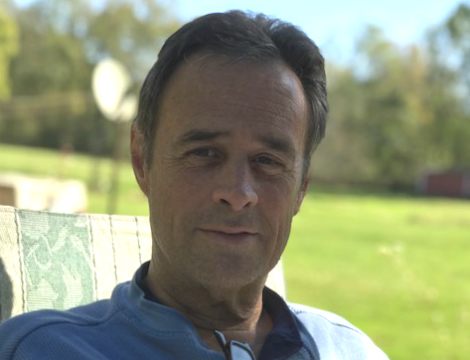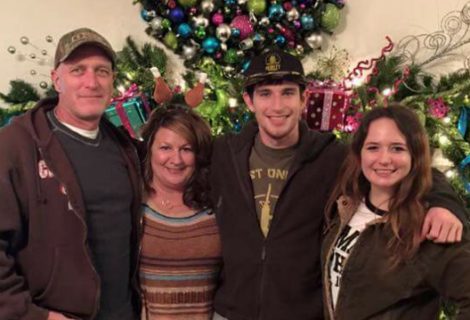Navy Veteran Pursues Mesothelioma Immunotherapy Trials

Written by Matt Mauney | Edited by Walter Pacheco | Last Update: 10/25/2024 | 8 Min Read
Calling Jim and Pam McWhorter the “outdoors type” would be an understatement.
The couple traveled regularly, enjoying hiking, camping and kayaking. In August 2014, they hiked 2,000 feet to the summit of Mount Washburn, a prominent mountain peak within Yellowstone National Park.
Eighteen months later, their lives changed when Jim got sick and was eventually diagnosed with pleural mesothelioma in May 2016.
“Today, he can barely walk two miles on a flat trail,” Pam told Asbestos.com from their home in Canton, Ohio. “Quality of life really takes a hit when cancer strikes.”
Jim, a 20-year Navy veteran, has kept a positive outlook through everything. A pleurectomy and decortication (P/D) and four rounds of chemotherapy removed all visible tumors until May 30, 2017, when the cancer returned in full force.
A CT scan revealed new spots on his left lung, lymph glands and liver. The cancer was now inoperable.
Jim was able to get into a clinical trial at Dana-Farber Cancer Institute in Boston, testing a combination of the immunotherapy drugs durvalumab and tremelimumab.
For the first few months, the results were extremely positive. The cancer had stabilized.
Unfortunately, a CT scan on Dec. 5 revealed new tumor growth, enough to remove Jim from the clinical trial.
That hasn’t stopped Pam, however. She is busy searching for other options, including getting Jim in contact with specialists at the National Institutes of Health Clinical Center in Bethesda, Maryland.
“I am already making connections to see if he qualifies for other trials, and as a fallback we go for more chemo to shrink the tumors until we do find a better immunotherapy treatment,” Pam said. “We’re attacking this like a warrior and not settling for less than the best.”

Pam and Jim McWhorter during a zip-line adventure in 2013.
In the meantime, Jim continues to push himself. Although there are no planned trips to national parks in the near future, he continues to climb mountains, figuratively, every day.
“Walking helps tremendously with breathing,” Jim said. “I can’t express that enough. [Mesothelioma] patients need to get out and work those lungs. Right now, I’ve been trying to get up to my two miles a day of walking. I keep pushing it.”
A Frustrating Journey to the Truth
The McWhorters’ path to a mesothelioma diagnosis was long and frustrating, a common issue for patients with the rare, asbestos-related cancer.
Jim’s primary care doctor and doctors at his local VA clinic had never seen mesothelioma before and wrote off symptoms as less-serious conditions.
It all started in September 2015, when Jim tripped over something in the basement of their home and caught himself in the doorway. Thinking he may have hyperextended his chest muscles or possibly cracked a rib, Jim went to the VA for an X-ray.
He was told the X-rays came back clear. It wasn’t until March 2016, during an unrelated pharmacy visit, he would find out the scans revealed a telling sign of what was to come.
“They noted on his medical records that there was thickening on the outside of the left lung and diagnosed it as COPD, but they never told him,” Pam explained. “So we were alarmed that they diagnosed him with something potentially life threatening but never let him know.”
A few weeks earlier, Jim had received a pneumonia shot and became very ill, with trouble breathing and intense pain under his left ribcage.
Another chest X-ray revealed a buildup of fluid around his left lung. After a CT scan, doctors removed the fluid.
Six weeks after the drainage, the fluid returned and doctors said an infection had built up. Another CT scan was given, and what was meant to be a routine decortication to remove the infection discovered what appeared to be tumors.
Doctors again said there was nothing to worry about, even after Pam suspected it may be mesothelioma.
Pam and Jim didn’t see the CT scan results initially, which is something she urges other mesothelioma survivors to push for.
“The doctors are telling us it’s just an infection — three doctors, including our family doctor, and the surgeon,” Pam said. “We got the CAT scan report after his surgery, and on that report from April, it said ‘Nodular thickening, suspect for mesothelioma, doctors should take immediate action.’ Three doctors missed or completely ignored that warning. If we had seen that warning, we would have taken a different path with surgery or sought out a specialist.”
Becoming Their Own Advocates
If the drawn-out diagnostic process taught the McWhorters anything, it was the importance of being your own advocate.
“We know mesothelioma is very specific and very hard to treat, and nobody here knows anything about it,” Pam said. “That taught us a lesson that you have to be your own advocate for your medical care. You have to request the documents, read it yourself and become versed in the medical terminology, so you can make better decisions.”
After the tumors were finally tested, the pathology report revealed it was pleural mesothelioma with the epithelioid cell type.
Pam was able to get Jim into the Cleveland Clinic to see a mesothelioma specialist and a thoracic surgeon.
“They only gave me six to 12 months to live,” Jim said. “The doctors said if they did the pleurectomy, it would extend my life by two to four months. My prognosis wasn’t very good, and I quit listening to it.”
After not getting the answers they were looking for, the McWhorters searched outside their home state, connecting with Dr. Joseph Friedberg at University of Maryland Greenebaum Cancer Center in Baltimore.
“He agreed to do the surgery and said ‘I’m not going to give you a prognosis — it’s not up to me how long you live — I’ll give you the best chance to make it through this disease, but it’s between you and your God how long you live,’” Pam recalled. “Another lesson in all this is to not be afraid to cancel your appointments and change doctors at the last minute.”
The surgery lasted seven hours. Doctors described the tumor as an orange rind that had entirely encased Jim’s left lung. It was three-quarters to an inch thick in diameter and up to two inches in some places.
“Dr. Friedberg said it was the largest tumor he had ever seen, and he had done over a hundred of those surgeries,” Jim said. “It was large enough to fill a two-liter Pepsi bottle.”
After returning home, Jim received multiple rounds of chemotherapy. He went about 11 months without any signs of recurrence before the cancer returned.
The McWhorters pursued proton radiation therapy before finding the immunotherapy clinical trial at Dana-Farber.
“I knew immunotherapy was something they were working on, but it seemed very far out of reach for us,” Pam said. “I kept it in my background, but I never thought we would qualify.”
When Jim was dismissed from the Dana-Farber study — after scans showed new tumor growth — Pam immediately started looking for other immunotherapy clinical trials.
“We are not sitting still, but digging into other options,” Pam said.
Military Asbestos Exposure Put Jim on Alert
During his stint in the Navy, Jim served on the USS Francis Marion, a Paul Revere-class attack transport. The ship was launched in 1954 and commissioned by the Navy in 1961 — a period when asbestos use was rampant.
In 1978, Jim served on the Francis Marion when the ship was involved in a collision, releasing asbestos dust from the bulkheads.
For about six weeks, Jim and a small crew walked through this asbestos-contaminated environment without protective equipment, unknowing of the dangers.
“After about six weeks of showing contractors around the ship, the Navy came in and taped everything off, confirming the dust was asbestos,” Pam said. “By then, though, it was too late.”
And that wasn’t his only run-in with the toxic mineral. Jim worked as a gunner’s mate, working on the electrical systems of the guns aboard ships. He also worked with hydraulic pumps and was once in charge of lighting the boilers in the boiler room of a ship — one of the most high-risk areas for asbestos exposure.
The ships needed to be fireproof, so virtually everything included asbestos.
“The mattress ticking, the pillow ticking, even the curtains on the racks, everything was laden with it,” Jim said.
At the time, however, Jim wasn’t aware of the dangers of asbestos, like so many other service members.
“This was all after the fact,” he said. “It was too late then.”
Jim, mindful of his history of asbestos exposure in the military, was always conscious of what could happen to him.
He has taken the punches and keeps fighting. His focus now is being a mentor to other patients going through similar battles.
“We had someone mentoring us in the beginning, who’s actually doing very well and has become a good friend,” Pam said. “So now, Jim is seeing it as an opportunity to pay it forward. What we’d like to do is help other veterans navigate the red tape and get the treatment and resources they need.”






